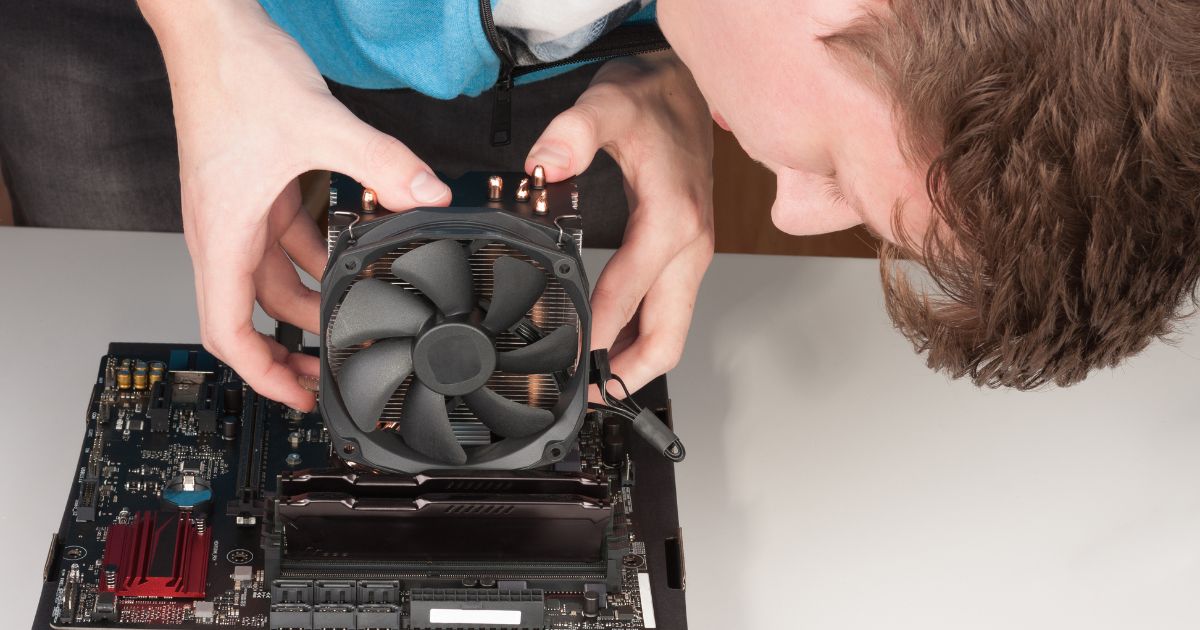Normal CPU Temperature While Gaming – Cooling Solutions & Tips
When it comes to gaming on your computer, one of the primary concerns is ensuring that your hardware stays within safe operating temperatures. Among the key components, the CPU (Central Processing Unit) is the workhorse, handling complex calculations and instructions, making it prone to heating up, especially under heavy loads like gaming and understanding what constitutes a normal CPU temperature. In contrast, gaming is crucial for maintaining performance and longevity. Let’s delve into this topic to shed light on what gamers should expect.

Factors Influencing CPU Temperature:
Before diving into specific temperature ranges, it’s essential to grasp the factors that influence CPU temperature during gaming sessions:
- Cooling System: The effectiveness of your cooling solution, whether it’s air or liquid cooling, plays a significant role. Efficient cooling systems can dissipate heat more effectively, keeping temperatures in check.
- Ambient Temperature: The ambient temperature of the room where your computer is located can impact CPU temperatures. A higher ambient temperature can make it more challenging for your cooling system to maintain lower CPU temperatures.
- Hardware Configuration: The CPU itself, along with other hardware components like the GPU (Graphics Processing Unit) and motherboard, can affect overall system temperature. Additionally, overclocking your CPU can lead to higher temperatures.
- Gaming Load: The intensity of the game being played directly affects CPU usage and, subsequently, its temperature. More demanding games with complex graphics and physics calculations tend to stress the CPU more, leading to higher temperatures.
Normal CPU Temperature Range While Gaming:
The ideal temperature range for a CPU while gaming varies depending on several factors, including the CPU model, cooling solution, and ambient conditions. However, as a general guideline, most CPUs operate optimally within the following temperature ranges:
- Idle Temperature: When your computer is at rest and not performing demanding tasks, the CPU temperature should typically range between 30°C and 45°C. Modern CPUs often have advanced power management features that allow them to operate at very low temperatures during idle periods.
- Under Load Temperature: During gaming or other intensive tasks, CPU temperatures can rise significantly. While it’s normal for temperatures to increase, they should generally remain below 80°C to 85°C to ensure optimal performance and prevent thermal throttling.
- Peak Temperature: Occasionally, during particularly demanding moments in a game or under synthetic stress tests, CPU temperatures may briefly spike higher. However, these spikes should be temporary, and the CPU should quickly return to within the safe operating range.
Monitoring and Managing CPU Temperature:
To ensure your CPU stays within safe temperature limits while gaming, it’s essential to monitor its temperature regularly. There are several software tools available that allow you to monitor CPU temperature in real time. Additionally, optimizing your PC’s airflow, cleaning dust from cooling components, and applying high-quality thermal paste when installing or reseating the CPU cooler can help maintain lower temperatures.
How to Check Your Computer’s CPU Temperature:
There are several methods to check your CPU temperature:
- BIOS/UEFI: Access your computer’s BIOS or UEFI interface during startup, where you can often find CPU temperature readings.
- Software Tools: Many third-party software tools, such as Core Temp, HWMonitor, or SpeedFan, provide real-time CPU temperature monitoring within your operating system.
- Built-in Operating System Utilities: Some operating systems, like Windows 10, have built-in performance monitoring tools that display CPU temperature alongside other system metrics.
How to Check CPU Temp Without BIOS:
If you can’t access your BIOS or prefer not to, software tools like Core Temp or HWMonitor provide convenient alternatives for monitoring CPU temperature within your operating system.
How to Monitor Your CPU Temperature Constantly:
Using software tools mentioned earlier, you can set up temperature alerts or log CPU temperature data over time to monitor it constantly and detect any unusual spikes or patterns.
How to Monitor Your CPU Temperature While Gaming:
During gaming, CPU temperatures can spike due to increased workload. Monitoring software with an overlay feature allows you to monitor CPU temperature in real time while gaming without interrupting your experience.
How to Keep Down CPU Temperatures:
To maintain lower CPU temperatures, consider the following:
- Clean your computer regularly to remove dust buildup from cooling components.
- Ensure proper airflow within your computer case by optimizing fan placement and cable management.
- Consider upgrading your CPU cooler to a more efficient air or liquid cooling solution.
- Avoid excessive overclocking, especially without adequate cooling.
- Monitor and adjust fan speeds or CPU clock speeds as needed to keep temperatures within safe limits.
- By following these tips, you can effectively monitor and manage your computer’s CPU temperature, ensuring optimal performance and longevity for your hardware, especially during intense gaming sessions.
Also Read: What is Overdrive on a Monitor? Enhancing Visual Performance
FAQs:
What CPU Temperature Is Normal?
While normal CPU temperatures vary depending on factors like CPU model, cooling solution, and workload, a typical range is between 30°C to 45°C at idle and below 80°C to 85°C under load.
Why Is My CPU Temp So High?
Several factors can contribute to high CPU temperatures:
- Inadequate Cooling: Dust buildup, insufficient airflow, or a malfunctioning cooling system can lead to elevated CPU temperatures.
- Overclocking: Pushing your CPU beyond its intended limits through overclocking can generate more heat than your cooling system can dissipate.
- High Ambient Temperatures: A hot environment can make it harder for your cooling system to keep your CPU temperature down.
- Intensive Tasks: Running demanding applications or games that stress your CPU can cause temperatures to rise.
What is a good CPU Temperature for gaming?
While gaming, it’s ideal to keep CPU temperatures below 80°C to 85°C to prevent thermal throttling and ensure optimal performance.
How hot should my CPU be while gaming?
Keep it under 80°C to 85°C for optimal performance and to avoid potential issues.
Is 90°C bad for the CPU?
Yes, it’s high and can lead to performance reduction and hardware damage.
Is 80 degrees normal for the CPU while gaming?
It’s at the upper limit of normal; monitor closely and take steps if it’s consistent.
Is 70°C CPU temp bad while gaming?
No, it’s generally acceptable, but monitor and maintain if it rises steadily.
Conclusion:
While there’s no one-size-fits-all answer to the question of what constitutes a “normal” CPU temperature while gaming, understanding the factors that influence CPU temperature and monitoring it regularly can help ensure optimal performance and longevity of your gaming rig. By keeping temperatures within safe limits and employing proper cooling solutions, gamers can enjoy immersive gaming experiences without the fear of overheating their hardware.


